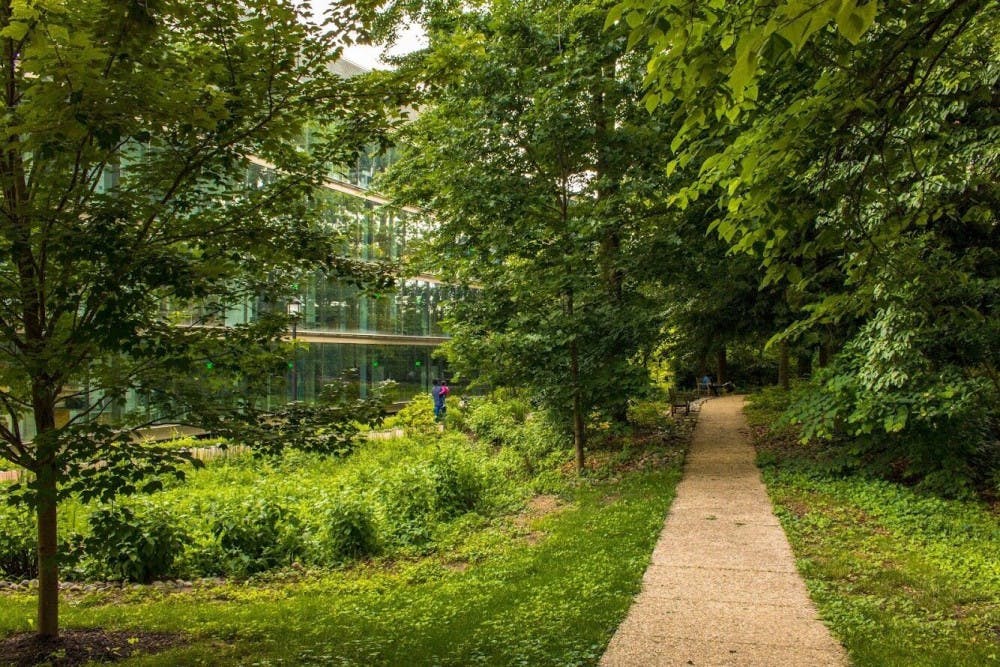The outdoor spaces of the University’s nearly 140-acre Homewood Campus are maintained by a team of 15 groundskeepers, overseen by Grounds Manager John Beauchamp. Together, they care for everything from the flower beds and hedges, to the quads and small forested areas, and even the brick sidewalks, one of the unique landscape features established after a donation to Hopkins Grounds Services nearly two decades ago.
Each portion of campus is maintained by a designated groundskeeper, who takes care of all the tasks in that area.
Beauchamp explained that the work varies based on the season.
“Certain times of the year dictate what we’re doing,” Beauchamp said in an interview with The News-Letter. “This time of the year we’re mowing, trimming, edging, weeding, and we’re going to get quickly into fall, so then we’ll be in leaf removal, leaf cleanup, litter cleanup and prepping for winter.”
During the winter, the team focuses on snow removal. With spring comes planting and maintenance, as well as a renewal of outdoor activities that Grounds Services may be involved in, including dealing with litter and waste collection.
One tool that Grounds Services regularly uses is a geographic information system (GIS) which includes information about every tree on campus.
Beauchamp established this type of mapping system at Hopkins. He had previously used it to keep track of trees while working at the Arlington National Cemetery and later at Gettysburg College.
Since then, GIS has been adopted for uses outside of groundskeeping.
“They’re beginning to use GIS for lots of things in facilities, and they have a whole separate department now,” Beauchamp said.
The department also did a flyover of campus and took aerial photos, which were used to create a new base map for the tree mapping system. The new base map is more accurate than the one created when GIS was first established.
“What I would do is I would print out a map showing where all the sidewalks are and things like that, and I would estimate the location of the trees,” Beauchamp said of the work to compile the original base map. “Once we got that aerial photo, I was able to much more accurately geolocate them.”
Information about the species and diameter of each tree has also been compiled.
In addition to maintenance, Grounds Services has ongoing projects around campus.
One involves the Bufano Sculpture Garden, near the Undergraduate Teaching Labs, which is currently a remnant forest.
“I want to try and reestablish it as a forest,” Beauchamp said. “We’ve been spending some money on removing invasive species, but we are being selective about removal and leaving native species there because I want to establish an understory of plants so that it becomes a true forest.”
Similar work to remove invasive species has also been underway in other locations, including the area between Bloomberg Center and the Hopkins Club, and the area to the west of Levering Hall.
While the impact of invasive species is more evident, the impact of climate change has been less so.
One change over the years has been in the U.S. Department of Agriculture’s Plant Hardiness Zone Map.
This map divides the U.S. into 13 zones, each spanning 10 degrees Fahrenheit and based on the average annual minimum winter temperature. The higher the zone number, the warmer the area, so the map can be used to gauge whether a species of plant is likely to grow well in a particular location.
“This used to be strictly a zone seven but it’s almost a zone eight now,” Beauchamp said of Homewood Campus. “We are planting a lot more southern species here. We’re planting some crepe myrtles, some bald cypress, plants that are really more southern.”
However, Beauchamp clarifies that it is difficult to determine whether, or to what extent, these shifts are a result of climate change.
“I don’t know that I could directly attribute that to climate change, but it just is occurring in the horticultural industry,” Beauchamp said of the changing zones. “And I don’t know if I could point out an impact from climate change on plant material on campus. I don’t think there’s been enough research to say.”
He suggested that regardless of how Homewood Campus may change in the future, it can rely on a group of dedicated groundskeepers.
“They’re the ones who really make campus look the way it does,” Beauchamp said. “They put their hearts into it. It means a lot to them, and that means a lot to me.”





